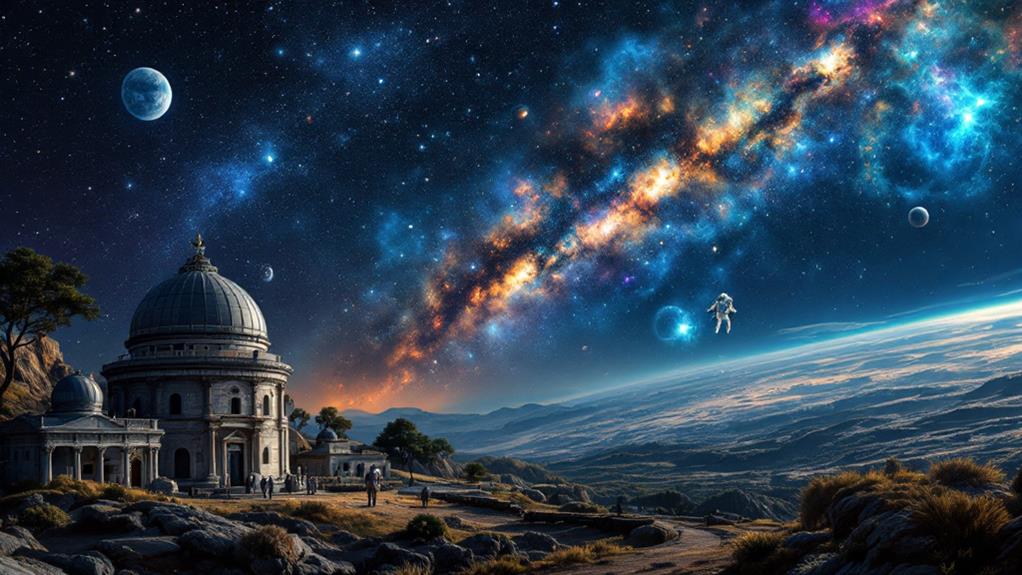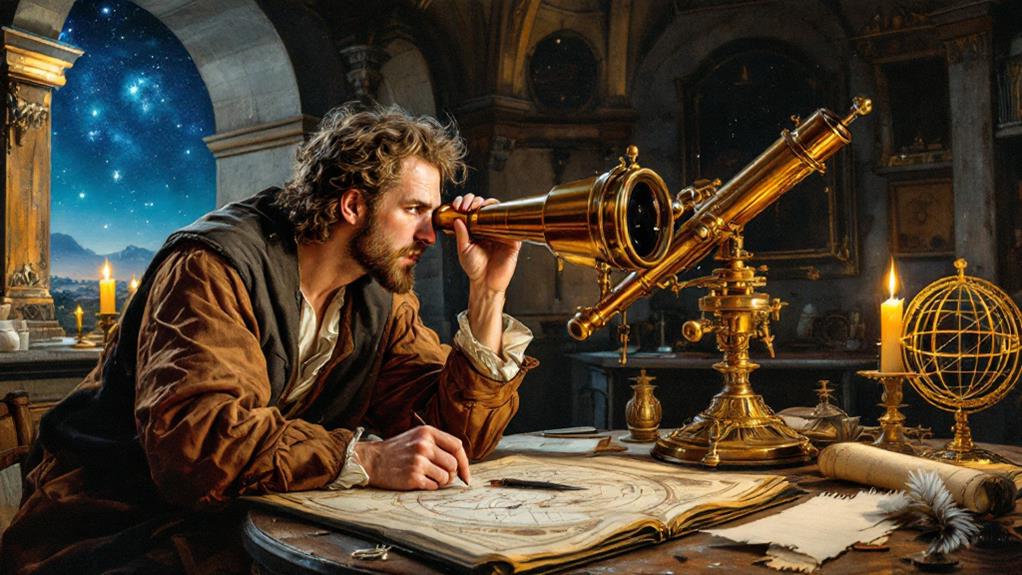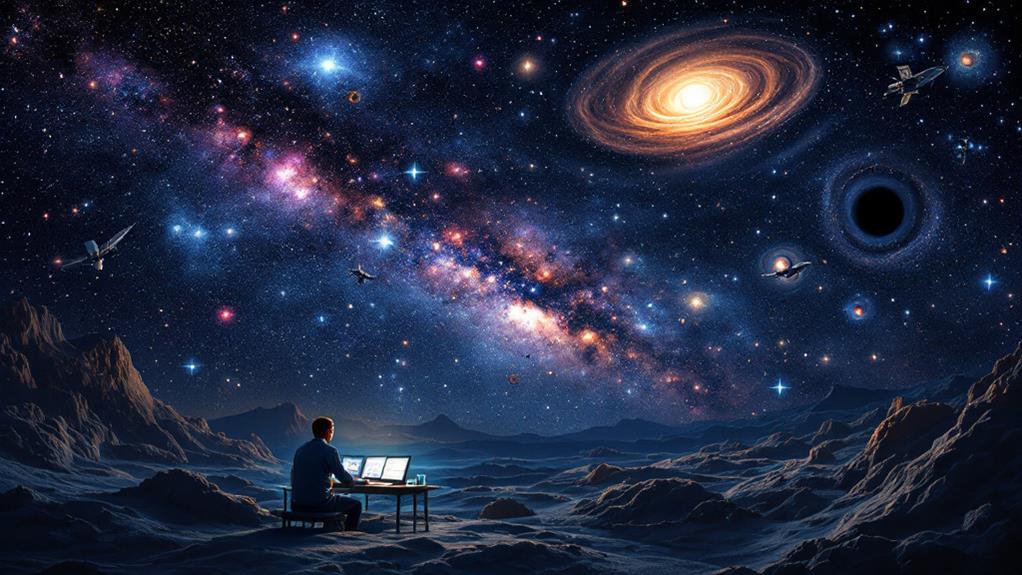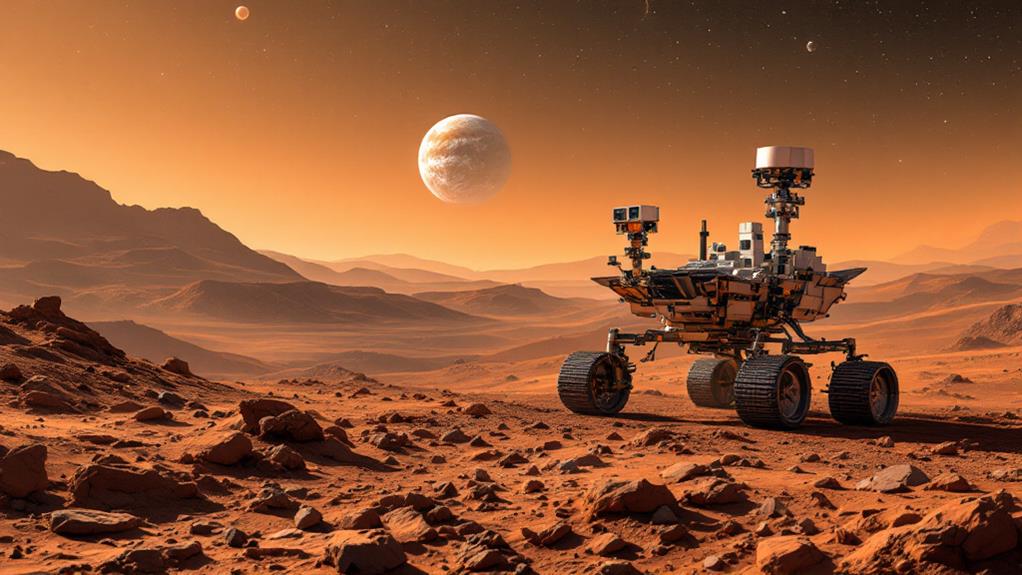The History of Astronomy: From Ancient Stargazing to Space Exploration

Astronomy's history spans millennia, from ancient civilizations tracking celestial movements to modern space exploration. You'll find early contributions from Babylonians, Egyptians, and Greeks, who developed calendars and star catalogs. The Renaissance brought revolutionary ideas, like Copernicus's heliocentric model and Galileo's telescopic observations. As technology advanced, so did our understanding of the cosmos. Einstein's theories reshaped our view of space-time, while the Space Race propelled us beyond Earth. Today, we're uncovering exoplanets and probing the universe's origins. This expedition of exploration continues, with each breakthrough opening new frontiers in our quest to understand the cosmos.
Ancient Astronomical Observations
Throughout human history, people have gazed at the sky with wonder and curiosity. Ancient civilizations across the globe made significant contributions to astronomical knowledge, laying the foundation for modern astronomy. You'll find evidence of these early observations in ancient structures and artifacts from various cultures.
The Babylonians, Egyptians, and Chinese were among the first to develop sophisticated celestial calendars. They carefully tracked the movements of celestial bodies, using their observations to predict seasons and plan agricultural activities. These early astronomers also conducted detailed lunar cycle observations, which helped them create accurate lunar calendars.
In Mesoamerica, the Maya built elaborate observatories and developed complex mathematical systems to track planetary motions. Meanwhile, in Stonehenge, England, you can see how Neolithic people aligned massive stone structures with celestial events like solstices and equinoxes.
Ancient Greek astronomers, such as Aristotle and Ptolemy, made significant advancements in understanding planetary motions and developing mathematical models of the cosmos. Their work influenced astronomical thinking for centuries to come, shaping our understanding of the universe and our place within it.
Greek and Roman Contributions
Building upon the foundations laid by earlier civilizations, Greek and Roman astronomers made pioneering contributions to the field of astronomy. You'll find that their advancements were both observational and theoretical, shaping our understanding of the cosmos for centuries to come.
Greek astronomers like Eratosthenes accurately calculated Earth's circumference, while Hipparchus created the first star catalog and uncovered the precession of equinoxes. The Greeks also formalized the concept of Zodiac constellations, which played an indispensable role in their astrological beliefs and astronomical observations.
Roman scholars, such as Ptolemy, built upon Greek knowledge. Ptolemy's geocentric model of the universe, though incorrect, remained influential for over a millennium. His work "Almagest" became a cornerstone of astronomical study.
These ancient thinkers engaged in philosophical debates about the nature of celestial bodies and their movements. While some of their ideas were later disproven, their methods of systematic observation and mathematical analysis laid the groundwork for modern scientific inquiry.
Greek and Roman contributions weren't limited to theory. They developed instruments like the astrolabe and armillary sphere, which revolutionized celestial navigation and timekeeping.
The Renaissance and Enlightenment

The Renaissance and Enlightenment periods marked a seismic shift in astronomical thought and practice. You'll find that this era saw the rise of the heliocentric model, challenging the long-held geocentric view of the universe. Nicolaus Copernicus proposed that the Sun, not Earth, was at the center of our solar system, sparking a scientific revolution that would reshape our understanding of the cosmos.
As you explore deeper into this period, you'll encounter pioneering figures like Galileo Galilei, who used the newly invented telescope to observe Jupiter's moons and Venus's phases, providing vital evidence for the heliocentric model. Johannes Kepler's laws of planetary motion further refined our understanding of celestial mechanics.
The scientific revolution in astronomy wasn't limited to theory. You'll see how improved instruments and observational techniques led to more accurate measurements and predictions. Isaac Newton's laws of motion and universal gravitation unified terrestrial and celestial physics, explaining planetary orbits and tides. This era laid the foundation for modern astronomy, setting the stage for future revelations and our current understanding of the universe.
Telescopes and Celestial Discoveries
As telescopes became more powerful and sophisticated, astronomers' ability to peer into the cosmos expanded dramatically. You can trace this revolution back to Galileo's first use of a telescope for astronomical observations in 1609. His rudimentary instrument unveiled Jupiter's moons, Saturn's rings, and the phases of Venus, challenging the geocentric model of the universe.
The next two centuries saw rapid advancements in optics innovation. You'd find larger and more precise telescopes being built, culminating in William Herschel's detection of Uranus in 1781. By the 19th century, spectral analysis emerged as a game-changing technique. You could now determine the chemical composition of celestial bodies by analyzing the light they emitted.
These tools led to a cascade of discoveries. You'd see astronomers identifying new planets, mapping the Milky Way, and even detecting the expansion of the universe. The Hubble Space Telescope, launched in 1990, took this exploration to new heights. You can now observe distant galaxies, witness star formation, and study the early universe, all thanks to these incredible instruments.
Modern Astrophysics and Cosmology

Novel theories and state-of-the-art technology have revolutionized our understanding of the universe in the modern era of astrophysics and cosmology. You'll find that the field has expanded dramatically since the early 20th century, with groundbreaking revelations shaping our view of the cosmos.
Einstein's theory of general relativity laid the foundation for modern cosmology, leading to the Big Bang theory and the concept of an expanding universe. In recent years, you've witnessed the detection of gravitational waves, confirming Einstein's predictions and opening a new window into the universe.
The uncovering of dark energy in the late 1990s has further transformed our understanding of cosmic expansion. You'll learn that this mysterious force is causing the universe to accelerate its expansion, challenging previous assumptions about gravity and the fate of the cosmos.
Advanced telescopes and space-based observatories have allowed you to peer deeper into space and time than ever before. These instruments have revealed the early universe, distant galaxies, and exoplanets, expanding your knowledge of cosmic evolution and the potential for life beyond Earth.
Space Race and Lunar Missions
Cold War tensions between the United States and Soviet Union sparked a fierce competition to achieve dominance in space exploration, known as the Space Race. You'd witness rapid advancements in satellite technology and rocketry as both nations vied for supremacy. The Soviets initially led the race, launching the first artificial satellite, Sputnik 1, in 1957 and sending the first human, Yuri Gagarin, into space in 1961.
The U.S. responded with ambitious goals, culminating in President Kennedy's 1961 declaration to land a man on the Moon by decade's end. NASA's Apollo program achieved this feat on July 20, 1969, when Neil Armstrong and Buzz Aldrin became the first humans to walk on the lunar surface.
The Space Race brought about numerous technological innovations and scientific revelations:
- Improved satellite technology for communications and weather forecasting
- Advanced materials and computer systems
- Medical breakthroughs from studying the effects of spaceflight on the human body
As tensions eased, international cooperation in space exploration increased. The Apollo-Soyuz Test Project in 1975 marked the first joint U.S.-Soviet space mission, opening the door for future collaborations like the International Space Station.
Robotic Exploration of Solar System

Beyond the Moon, astronomers turned their attention to probing other celestial bodies in our solar system. You'll find that the robotic exploration of our cosmic neighborhood has been a remarkable undertaking of discovery.
Unmanned probes have been essential in this endeavor, allowing scientists to study planets, moons, asteroids, and comets up close. These sophisticated machines have braved extreme conditions to beam back invaluable data and images. You've likely seen stunning photos of Mars' red vistas or Jupiter's swirling storms, all captured by these robotic explorers.
Interplanetary missions have revolutionized our understanding of the solar system. You can trace this progress from early flybys to orbiters, landers, and even sample return missions. Each venture has unveiled new mysteries and challenged existing theories. From mapping Venus' surface through its thick atmosphere to sampling the icy plumes of Saturn's moon Enceladus, these missions have expanded our cosmic perspective.
As you look to the future, robotic exploration continues to push boundaries. With advanced technologies and ambitious goals, we're set to uncover even more secrets of our celestial neighbors.
Exoplanets and Deep Space Astronomy
In the last few decades, astronomy has expanded its horizons far beyond our solar system. You've witnessed a revolution in our understanding of the universe, thanks to advancements in extrasolar planet detection and galactic structure analysis. Scientists have encountered thousands of exoplanets, revealing a diverse array of worlds that challenge our preconceptions about planetary formation and habitability.
Deep space astronomy has allowed you to peer into the farthest reaches of the cosmos, uncovering the secrets of galaxy evolution and the nature of dark matter and dark energy. With powerful telescopes and sophisticated data analysis techniques, you can now:
- Detect Earth-like planets in distant star systems
- Map the structure of the Milky Way and other galaxies
- Study the early universe through observations of ancient light
These breakthroughs have opened up new avenues for research and sparked public imagination about the possibilities of life beyond Earth. As technology continues to advance, you can expect even more exciting findings in the field of exoplanets and deep space astronomy, pushing the boundaries of human knowledge further into the cosmos.



